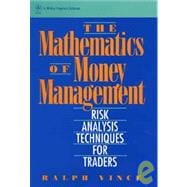
Note: Supplemental materials are not guaranteed with Rental or Used book purchases.
Purchase Benefits
Looking to rent a book? Rent The Mathematics of Money Management Risk Analysis Techniques for Traders [ISBN: 9780471547389] for the semester, quarter, and short term or search our site for other textbooks by Vince, Ralph. Renting a textbook can save you up to 90% from the cost of buying.
| Preface | v | ||||
| Introduction | xi | ||||
| Scope of This Book | xi | ||||
| Some Prevalent Misconceptions | xv | ||||
| Worst-Case Scenarios and Strategy | xvi | ||||
| Mathematics Notation | xviii | ||||
| Synthetic Constructs in This Text | xviii | ||||
| Optimal Trading Quantities and Optimal f | xxi | ||||
|
1 | (62) | |||
|
1 | (3) | |||
|
4 | (1) | |||
|
5 | (4) | |||
|
9 | (5) | |||
|
14 | (2) | |||
|
16 | (4) | |||
|
20 | (1) | |||
|
21 | (4) | |||
|
25 | (1) | |||
|
26 | (1) | |||
|
27 | (3) | |||
|
30 | (2) | |||
|
32 | (2) | |||
|
34 | (1) | |||
|
35 | (3) | |||
|
38 | (1) | |||
|
39 | (1) | |||
|
40 | (5) | |||
|
45 | (1) | |||
|
46 | (3) | |||
|
49 | (4) | |||
|
53 | (5) | |||
|
58 | (5) | |||
|
63 | (35) | |||
|
63 | (2) | |||
|
65 | (3) | |||
|
68 | (3) | |||
|
71 | (2) | |||
|
73 | (3) | |||
|
76 | (4) | |||
|
80 | (2) | |||
|
82 | (1) | |||
|
83 | (6) | |||
|
89 | (3) | |||
|
92 | (3) | |||
|
95 | (3) | |||
|
98 | (51) | |||
|
98 | (2) | |||
|
100 | (3) | |||
|
103 | (5) | |||
|
108 | (1) | |||
|
109 | (2) | |||
|
111 | (4) | |||
|
115 | (9) | |||
|
124 | (1) | |||
|
125 | (7) | |||
|
132 | (17) | |||
|
149 | (44) | |||
|
149 | (4) | |||
|
153 | (7) | |||
|
160 | (8) | |||
|
168 | (7) | |||
|
175 | (1) | |||
|
176 | (1) | |||
|
177 | (1) | |||
|
178 | (12) | |||
|
190 | (2) | |||
|
192 | (1) | |||
|
193 | (44) | |||
|
194 | (3) | |||
|
197 | (2) | |||
|
199 | (9) | |||
|
208 | (5) | |||
|
213 | (11) | |||
|
224 | (1) | |||
|
225 | (3) | |||
|
228 | (5) | |||
|
233 | (4) | |||
|
237 | (29) | |||
|
238 | (12) | |||
|
250 | (8) | |||
|
258 | (8) | |||
|
266 | (28) | |||
|
266 | (5) | |||
|
271 | (7) | |||
|
278 | (5) | |||
|
283 | (4) | |||
|
287 | (1) | |||
|
287 | (7) | |||
|
294 | (75) | |||
|
294 | (8) | |||
|
302 | (9) | |||
|
311 | (1) | |||
|
312 | (8) | |||
|
320 | (4) | |||
|
324 | (2) | |||
|
326 | (1) | |||
|
327 | (1) | |||
|
328 | (3) | |||
| Appendixes | |||||
|
331 | (5) | |||
|
336 | (28) | |||
|
337 | (2) | |||
|
339 | (2) | |||
|
341 | (4) | |||
|
345 | (2) | |||
|
347 | (1) | |||
|
348 | (4) | |||
|
352 | (2) | |||
|
354 | (2) | |||
|
356 | (2) | |||
|
358 | (1) | |||
|
359 | (5) | |||
|
364 | (5) | |||
| Bibliography and Suggested Reading | 369 | (4) | |||
| Index | 373 |
The New copy of this book will include any supplemental materials advertised. Please check the title of the book to determine if it should include any access cards, study guides, lab manuals, CDs, etc.
The Used, Rental and eBook copies of this book are not guaranteed to include any supplemental materials. Typically, only the book itself is included. This is true even if the title states it includes any access cards, study guides, lab manuals, CDs, etc.